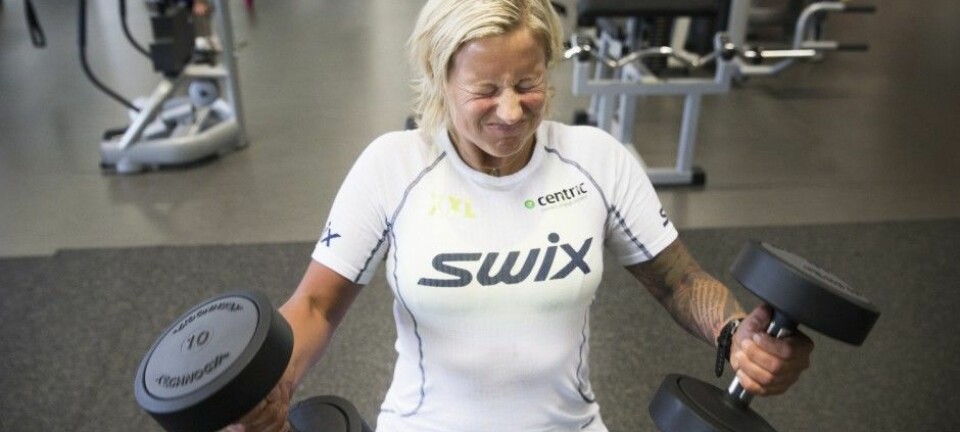
Women who use anabolic steroids encounter masculinizing side effects
The steroids impact their self-esteem, sexuality and social lives, but some women also experience positive side effects.
Researcher and psychiatrist Ingrid Amalia Havnes has interviewed female bodybuilders and looked into how their use of certain doping substances has impacted them physically, psychologically and socially.
Havnes explored what caused the women to start using anabolic-androgenic steroids (AAS), the resulting side effects and how they dealt with the adverse effects.
"This is a touchy matter. The women encounter plenty of stigmatization. So, they commonly don’t disclose their use of anabolic steroids to their family, friends inside and outside of their training environment," explains Havnes.
Many of the women were ashamed and suffered social problems linked to several of the side effects. But they could also feel what they deemed the positive effects from using these artificial testosterones.
"It’s important to understand that many encounter positive effects in this period of their lives. That can make it hard to quit using the substances," says Havnes.
The study is one of few undertaken regarding women who use such steroids.
Havnes carried out the study together with a research group at Oslo University Hospital researching AAS. She also works at the hospital treating patients who wish to quit using these steroids.
Little knowledge about the women
Anabolic-androgenic steroids are an artificially manufactured testosterone, used to increase muscle volume and strength. Their use was banned by law in Norway in 2013.
Havnes and her colleagues conducted thorough interviews of 16 women who were current or former AAS users.
Information is available from ample research regarding the specific side effects women risk when using these steroids. But little research has been directed at how women feel about these changes. SSA use and the damage it does to men has been more copiously researched.
Havnes points out that women who use anabolic steroids are a difficult group to reach.

Masculine features and shame
All the women who participated in the study experienced a number of undesired masculine traits with their use. Many were unprepared for this.
Increased facial hair, smaller breasts, a deeper voice and enlarged clitoris were among the negative effects.
"This inflicted them with shame, reduced self-esteem and social problems," says Havnes.
Over half in fitness circles
Ten of the women were from fitness or bodybuilding circles and had participated in regional, national or international competitions.
"The other six had not been engaged in such competitions, but they worked out with weights in combination with using AAS to achieve the bodies they sought," says Havnes.
Ten women had cut out the steroids and six were still using them.
In recent decades the female body ideal has changed in many minds from a slender to a muscular physique.
"This may have contributed to those involved in fitness circles being exposed to use of anabolic steroids," says Havnes.
Stronger and less body fat
Most said they had started with anabolic steroids because they wanted bigger muscles and less body fat.
Several who competed began with AAS after finding that the effect of working out had stagnated after years of intense training.
Some had only engaged in training for a short while and wanted a shortcut to progress in building muscle. This goal included both participants with and without fitness or bodybuilding competitions, explains Havnes.
Depended on male advice
Most of the women in the study were introduced to AAS by male partners who also used the drug, or by friends or coaches/trainers. The mean age of the women was 23 when they started as users.
They took the drugs in the form of pills or injections. They took lower dosages than men do, generally taking periodic breaks.
But they all encountered unwanted side effects, among some even after an impulsive, short-term use.
Many of the masculine traits persisted after they stopped using the hormone drugs.
"It is worrisome that the women trusted the knowhow of these men with regard to dosages, which drugs they used and the duration of the treatments," says Havnes.
The substances can lead to serious physical and psychological side effects, such as cardiovascular diseases, depression, anxiety and psychoses.
"The women were generally not too concerned about the risks for their livers or hearts. They were more afraid of masculinizing side effects," says Havnes.
Many had breast implants
Smaller breasts and more facial and body hair were common side effects. Some were troubled by problems with facial acne.
"Their breasts could shrink because of insufficient subcutaneous fat and the impact of steroids on breast tissue," explains Havnes.
But the women experienced these side effects as easier to deal with than others.
"They could neutralize this by removing undesirable hair growth and getting breast implants. Most of those who competed had these implants," says Havnes.
Ashamed of deeper voices
The women were more concerned about their deeper voices.
"There were examples of the voice getting so deep and gravelly that when they placed order on the phone, the person at the other end thought they were a man," says Havnes.
Many felt ashamed about their deeper voices and regretted the substance use on these grounds.
Few of the women communicated openly about their use of AAS with their families or friends inside and outside fitness circles. So, the change in voice could be what tipped others off about their use of the illegal substance.
Some did inform that their voices got less deep after quitting use of the drug but it still had not returned to its former, feminine pitch.
RELATED: If you're interested in more of our stuff on fitness, check out some of the following articles
- You can build strength without weights
- Is it possible to lose weight while building muscle?
- Is it really true that if you have a low resting heart rate, you’re really fit?
Bigger muscles and sexual desire
The women who had more impulsively opted to use steroids were very unprepared for the resulting masculine traits. Six of the women still used the steroids and felt the desired effect overshadowed the adverse side effects.
Most of them reported an increased libido after usage and they considered this a positive factor. But that was contingent on their life situation.
"It depended on whether they were in a relationship. Those who were with a man who also used steroids were particularly pleased by the increased desire," says Havnes.
Increased libido was contrarily felt as negative for those lacking a partner or if the usage led to genital changes.
Clitoris grew, periods stopped
Many found that their clitoris and to some extent their labia had grown. An enlarged clitoris reduced their self-esteem.
But these reactions were partly linked to how their partner reacted. If the partner was positive about the change this could counterbalance some of the women’s negative feelings.
Some experienced a tightening of their genitals.
"This could make intercourse difficult," says Havnes.
AAS usage also led to irregular menstruation or its total cessation. But this was not viewed as a problem - on the contrary.
The stoppage of menstruation was a sign that the drugs were effective. When their periods returned, they took that as a sign that it was safe to start using the AAS again.
Felt better psychologically
Anabolic-androgenic steroids also led to psychological changes which the women could deem positive. Many revealed that they had become more self-assured and fit.
Many gained control of difficult emotions that had afflicted them, for instance serious traumas.
Reduced empathy and emotional flattening were experienced by some as positive changes.
"One of the women said this helped her to isolate herself and focus on her education, job, work-outs and preparations for competitions," says Havnes.
Many of the women had been troubled with anxiety and the feelings of inferiority. Many said that being part of a gym and training environment was important for feeling they were in control; they lost their anxiety when they started with steroids.
Many also had been plagued with eating disorders, and they felt it was healthier to have a muscular body fuelled on steroids than starving themselves to get thin.
However, some of the women who had used AAS for a long time suffered mental problems and serious physical disorders. This prompted them to quit using the drug.
That said, their social belonging to training circles was bolstered by the progress they made using steroids.
Right to help without police involvement
The researcher says users are not helped by condemnation.
"We have to understand that many enjoy a positive effect for a stretch of their lives when using AAS," says Havnes.
She would like to encourage MDs and health officials to ask questions.
"The women who have used steroids might make appointments with their doctor to treat acne, missed periods or psychological afflictions from long-time use. It’s important for health personnel to query whether they use AAS, what motivated them to do so and whether they want help to quit," she says.
Havnes asserts that health personnel must meet users with knowledge without condemnation or stigmatization.
Participants in the study
The participants were recruited via social media in open and hidden forum groups, posters and flyers.
Three of the participants were coaches or personal trainers. Seven were students or worked health or other care services. Three worked within education or studied for jobs in that sector.
Ages ranged from 19 to 46 when they were interviewed.
On average they had used AAS for eight years before quitting or being interviewed by the researchers. Most had used the drug for periods off and on. A few had used AAS continuously from one to five years.
The investigation is part of a larger study about long-term use of anabolic steroids and its effect on the brain and behaviour, led by Astrid Bjørnebekk from Rusforsk, Oslo University Hospital. Ingrid Havnes works at Nasjonal kompetansetjeneste TSB, which deals with multidisciplinary specialized treatment of substance abuse and dependency disorders at the Oslo University Hospital.
Outlawed in 2013
When anabolic steroids were included in Norway’s laws and national approaches to treating substance abuse in 2013, users were simultaneously offered help in quitting and receiving treatment of their physical and psychological side effects in the specialist health services.
Oslo University Hospital provides individual information conversations about health risks and treatment. To date they have had such meetings with 600 anabolic steroid users and their families, informs Havnes. In these they are told the health services do not inform the police or their employer about their usage of the illegal substance.
Nevertheless, the criminalisation of anabolic steroids and other doping substances is felt to have erected a barrier against contact with the health services, according to male users of the substances.
Translated by Glenn Ostling
Reference:
Ingrid Amalia Havnes et al.: Anabolic-androgenic steroid use among women – A qualitative study on experiences of masculinizing, gonadal and sexual effects. International Journal of Drug Policy, 28 July, 2020. https://doi.org/10.1016/j.drugpo.2020.102876
———
Read the Norwegian version of this article at forskning.no


































